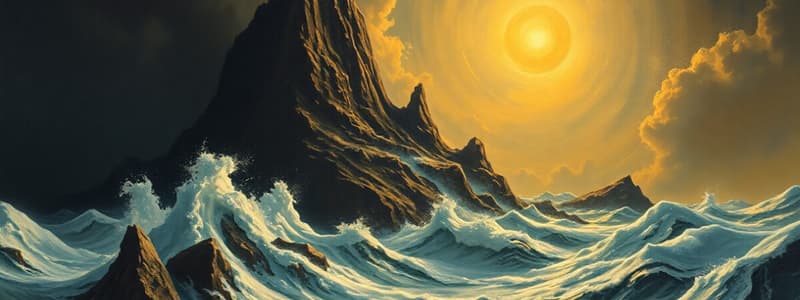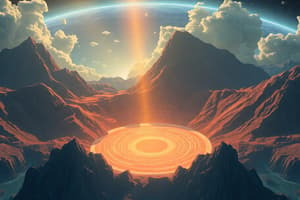Podcast
Questions and Answers
What type of rock is commonly formed at continent-continent convergent boundaries due to the stress from collisions?
What type of rock is commonly formed at continent-continent convergent boundaries due to the stress from collisions?
- Marble
- Basalt
- Granite
- Gneiss (correct)
Which natural disaster is most likely to occur at transform plate boundaries?
Which natural disaster is most likely to occur at transform plate boundaries?
- Volcanic eruptions
- Earthquakes (correct)
- Landslides
- Tsunamis
What geological process is responsible for creating new seafloor at mid-ocean ridges?
What geological process is responsible for creating new seafloor at mid-ocean ridges?
- Erosion
- Metamorphism
- Subduction
- Seafloor spreading (correct)
What type of geological activity, besides volcanic eruptions, is characterized at subduction zones?
What type of geological activity, besides volcanic eruptions, is characterized at subduction zones?
What feature was created by the Pacific and North American plates grinding past each other?
What feature was created by the Pacific and North American plates grinding past each other?
What is the name of the instrument that records earthquakes and can help locate the epicenter of an earthquake?
What is the name of the instrument that records earthquakes and can help locate the epicenter of an earthquake?
What is the term for the point on Earth’s surface directly above where an earthquake occurs?
What is the term for the point on Earth’s surface directly above where an earthquake occurs?
What type of plate boundary involves two plates moving towards each other?
What type of plate boundary involves two plates moving towards each other?
What geological feature is commonly associated with subduction zones?
What geological feature is commonly associated with subduction zones?
What force drives the movement of lithospheric plates around Earth’s surface?
What force drives the movement of lithospheric plates around Earth’s surface?
What happens to older seafloor as new oceanic crust forms at a mid-ocean ridge?
What happens to older seafloor as new oceanic crust forms at a mid-ocean ridge?
Which mountain range was formed by the collision of the Indian and Eurasian plates?
Which mountain range was formed by the collision of the Indian and Eurasian plates?
What type of volcano lies above the Hawaiian hot spot?
What type of volcano lies above the Hawaiian hot spot?
What type of geological feature is typically formed by the process of continental rifting?
What type of geological feature is typically formed by the process of continental rifting?
What type of tectonic activity is most prominent at subduction zones?
What type of tectonic activity is most prominent at subduction zones?
What occurs when two oceanic plates converge resulting in one plate descending beneath the other?
What occurs when two oceanic plates converge resulting in one plate descending beneath the other?
What geological feature often forms at divergent plate boundaries beneath the ocean?
What geological feature often forms at divergent plate boundaries beneath the ocean?
At transform plate boundaries, what natural phenomena are most likely to occur?
At transform plate boundaries, what natural phenomena are most likely to occur?
Which type of magma-related activity is generally associated with subduction zones?
Which type of magma-related activity is generally associated with subduction zones?
What geological process is responsible for the creation of new oceanic crust?
What geological process is responsible for the creation of new oceanic crust?
What major geological feature is a result of the Pacific plate interacting with the North American plate?
What major geological feature is a result of the Pacific plate interacting with the North American plate?
Where on the ocean floor can divergent plate boundaries typically be found?
Where on the ocean floor can divergent plate boundaries typically be found?
What kind of rock type is primarily formed at continent-continent convergent boundaries as a result of collision?
What kind of rock type is primarily formed at continent-continent convergent boundaries as a result of collision?
What type of plate boundary do two plates move away from each other?
What type of plate boundary do two plates move away from each other?
What geological process is responsible for the Pacific Ocean shrinking while the Atlantic Ocean grows?
What geological process is responsible for the Pacific Ocean shrinking while the Atlantic Ocean grows?
What happens when two continental plates collide at a convergent boundary?
What happens when two continental plates collide at a convergent boundary?
What is the term for geological activity that occurs away from plate boundaries?
What is the term for geological activity that occurs away from plate boundaries?
What is formed at mid-ocean ridges during seafloor spreading?
What is formed at mid-ocean ridges during seafloor spreading?
Which geological feature is commonly associated with island arcs?
Which geological feature is commonly associated with island arcs?
Which two plates are involved in the San Andreas Fault?
Which two plates are involved in the San Andreas Fault?
What geological feature results from the process of one oceanic plate plunging beneath another at a convergent boundary?
What geological feature results from the process of one oceanic plate plunging beneath another at a convergent boundary?
What is the name of the geological process where supercontinents form and break up over time?
What is the name of the geological process where supercontinents form and break up over time?
Which mountain range was formed by the collision of the Indian and Eurasian plates?
Which mountain range was formed by the collision of the Indian and Eurasian plates?
Flashcards are hidden until you start studying
Study Notes
Earthquakes and Plate Boundaries
- Seismometer: An instrument used to record earthquakes and help locate the epicenter.
- Epicenter: The point on Earth's surface directly above where an earthquake occurs.
- Faults: Large cracks in the ground associated with earthquakes.
Types of Plate Boundaries
- Divergent Plate Boundary: Two plates move away from each other.
- Convergent Plate Boundary: Two Plates move towards each other.
- Transform Plate Boundary: Two plates slip past each other.
Divergent Plate Boundary Features
- Mid-Ocean Ridges: Formed by seafloor spreading when magma rises and cools.
- Basalt: Igneous rock formed beneath lava at mid-ocean ridges.
Convergent Plate Boundaries:
- Subduction Zone: An area where one oceanic plate plunges beneath another.
- Trench: A deep depression in the ocean floor formed at subduction zones.
- Volcanic Arc: A line of volcanoes above a subducting oceanic plate.
- Island Arcs: Volcanic chains created by the subduction of oceanic crust beneath oceanic crust.
- Example: Aleutian Islands.
- Mountain Ranges: Formed when two continental plates collide.
- Example: Himalayan Mountains.
- Continent-Continent Collisions: Typically lack volcanoes due to the similar density of the plates.
Transform Plate Boundaries:
- San Andreas Fault: An example of a transform plate boundary.
- Length of the San Andreas Fault: 800 miles
Continental Drift and Supercontinents:
- Pangaea: The supercontinent theorized by Alfred Wegener that existed before the continents drifted apart.
- Supercontinent Cycle: The geological process of supercontinent formation and breakup over millions of years.
- Duration of a Supercontinent Cycle: Approximately 500 million years.
Global Geological Activity:
- Ring of Fire: Earth's most geologically active area, located around the Pacific Ocean.
- Pacific Shrinkage: The Pacific Ocean is shrinking due to subduction.
- Atlantic Growth: The Atlantic Ocean is growing due to seafloor spreading.
Intraplate Activity:
- Intraplate Volcanic Activity: Geologic activity occurring away from plate boundaries.
- Example: Hawaiian Islands.
- Hawaiian Hot Spot: Located within the Pacific Plate, it produces volcanoes like Mauna Loa.
Driving Forces of Plate Tectonics:
- Convection Currents: Movements in the mantle that drive the movement of lithospheric plates.
Seafloor Spreading and Plate Boundaries:
- Seafloor Spreading: The process of creating new seafloor at mid-ocean ridges.
- Divergent Plate Boundary: Where new oceanic lithosphere is formed.
Geological Processes:
- Metamorphic Rocks: Common at continent-continent convergent boundaries due to the intense pressure.
Plate Boundaries and Disasters:
- Earthquakes: The most likely natural disaster at transform plate boundaries.
Subduction Zone Features:
- Deep Ocean Trenches: Formed by subduction zones.
- Volcanic Arcs: Caused by rising magma from subduction zones.
- Magma Formation: Forms by the melting of oceanic crust as it subducts.
Landform Formation:
- San Andreas Fault: Created by the grinding of the Pacific and North American plates.
- Continental Rifting: Can occur within continents, causing the formation of rift valleys.
Earthquakes and Plate Boundaries
- Seismometer: Instrument that records earthquakes and helps locate their epicenter.
- Epicenter: Point on Earth's surface directly above an earthquake's origin.
- Faults: Large cracks in the Earth's crust where earthquakes occur
- Divergent Plate Boundaries: Plates move apart, forming mid-ocean ridges where new crust is created
- Convergent Plate Boundaries: Plates collide, resulting in mountains, volcanoes, and subduction zones
- Transform Plate Boundaries: Plates slide past each other horizontally, creating friction that can cause earthquakes.
Mid-Ocean Ridges and Seafloor Spreading
- Mid-Ocean Ridges: Underwater mountain ranges formed by the upwelling of magma from the Earth's mantle.
- Seafloor Spreading: Process of creating new oceanic crust at mid-ocean ridges as magma rises and solidifies.
- Extrusive Igneous Rock: Primarily found beneath lava at mid-ocean ridges.
Subduction Zones
- Subduction: Process where one oceanic plate dives beneath another at a convergent boundary.
- Trenches: Deep, narrow depressions in the ocean floor formed at subduction zones.
- Volcanic Arcs: Lines of volcanoes above a subducting oceanic plate.
- Island Arcs: Chains of volcanic islands formed by subduction zones.
- Example: The Aleutian Islands in Alaska.
Continental Collisions
- Mountain Ranges: Formed when two continental plates collide, as the crust buckles and rises.
- Example: The Himalayas, formed by the collision of the Indian and Eurasian plates.
- Lack of Volcanoes: Typically absent at continent-continent convergent boundaries due to the thick continental crust preventing magma from rising.
Transform Boundaries
- San Andreas Fault: Major transform boundary in California, extending for over 800 miles.
- Pacific and North American Plates: Plates involved in the San Andreas Fault.
Supercontinents and Plate Tectonics
- Pangaea: Supercontinent that Alfred Wegener proposed existed before the continents drifted apart.
- Supercontinent Cycles: Formation and breakup of supercontinents over vast geological time periods.
- Cycle Duration: Believed to take approximately 500 million years.
- Pacific Shrinking, Atlantic Growing: The Pacific Ocean is shrinking due to subduction zones, while the Atlantic Ocean is expanding due to seafloor spreading.
Intraplate Volcanic Activity
- Intraplate Activity: Geological activity occurring away from plate boundaries.
- Hawaiian Hot Spot: Example of intraplate activity, creating the Hawaiian Islands.
- Shield Volcanoes: Type of volcano found above the Hawaiian hot spot.
Driving Forces of Plate Tectonics
- Convection Currents: Movements of hot, fluid mantle material that drive the movement of lithospheric plates.
- Seafloor Age: Older seafloor is pushed away from mid-ocean ridges by new oceanic crust formation.
Geological Processes at Plate Boundaries
- Continent-Continent Convergent Boundaries: Common rock type is metamorphic rock due to the intense pressure and heat.
- Transform Plate Boundaries: Earthquakes are the most likely natural disaster.
- Subduction Zones: Earthquakes, volcanic activity, and mountain formation are characteristic features.
- Magma Formation at Subduction Zones: Water released from the subducting plate lowers the melting point of the mantle, forming magma.
Geographic Feature Created by Plate Interaction
- California's San Andreas Fault: Formed due to the Pacific and North American plates grinding past each other.
Studying That Suits You
Use AI to generate personalized quizzes and flashcards to suit your learning preferences.




